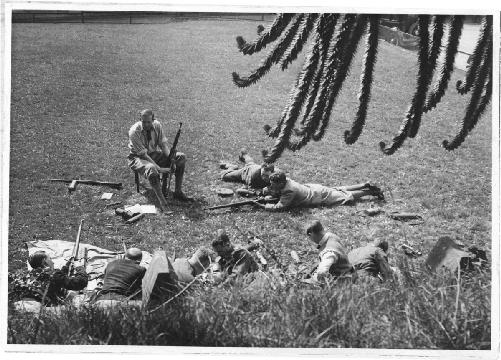Rogue Heroes: The History of the SAS, Britain's Secret Special Forces Unit That Sabotaged the Nazis and Changed the Nature of War (38 page)
Authors: Ben Macintyre
Tags: #World War II, #History, #True Crime, #Espionage, #Europe, #Military, #Great Britain
A long burst of machine-gun fire was followed by a series of single shots. Schönig later reported that “the parachutists died in an exemplary, brave and calm manner.” The three men still in the military hospital, too badly injured to be brought before the firing squad, were denied even the dignity of facing death with foreknowledge: six days after the executions at Saint-Sauvant, lying in their hospital beds, they were each injected with a lethal dose of morphine.
Lincoln Bundy was listed as “missing in action.” The sum of $397.21 was sent by the air corps to his mother in Cactus Flat, along with two shirts, two pairs of trousers, a tie, and a carton of belongings, “in order that you may safely keep it on behalf of the owner pending his return.”
In the village of Saint-Sauvant, word of the murders in the forest quickly spread.
On August 6, two RAF Hudsons touched down on a makeshift landing strip created by Tonkin and his men with “a jeep, a harrow and rake,” and the help of three downed American pilots. The planes took off, bumpily, a few minutes later, with a team of “happy SAS and three delirious Americans.”
Operation Bulbasket had succeeded in slowing down the advance of the panzers; it had inflicted extensive damage on rail and road networks, killed and injured large numbers of enemy troops, and substantially boosted the local French resistance. But at a terrible price. Quite how high that cost had been was hinted at in one of the last wireless messages sent to Tonkin: “Cases are preparing against war criminals [with a] mounting mass of evidence…forward to England by any secured means the names of enemy units and their responsible commanders who are guilty of atrocities.”

Aerial reconnaissance photograph of Capo Murro di Porco, target of the unit’s first landing in Sicily, a few hours ahead of the invasion on July 10, 1943.

Bill Stirling instructing trainee commandos outside Keir, the family home in Scotland.

John Tonkin and Paddy Mayne relaxing during the Italian campaign.

Bill Stirling (right), elder brother of David (left), the founder and first commander of 2SAS.

Jock McDiarmid, a Scotsman with a reputation for raw violence, whose actions in Italy and France blurred the distinction between rough justice and cold-blooded killing.

John Tonkin, the young officer captured at Termoli who subsequently escaped after enjoying dinner with the German general in command.

Reconnaissance photographs of Termoli taken shortly before Paddy Mayne’s men stormed and took the town, “the hinge-pin of the enemy line.”

Tragedy in Termoli. The chaotic and bloody aftermath of a direct hit by German shells on a truck carrying seventeen men.

Map of France identifying by code name the numerous SAS operations behind enemy lines after D-Day.

Roy Farran, alias “Paddy McGinty,” the most celebrated officer in 2SAS: inspiring, unconventional, and entirely ruthless.

“Battaglione McGinty.” Seated at center is the Italian woman partisan known as “Noris”: “As brave and dangerous as a tigress and completely devoted to the British company.”